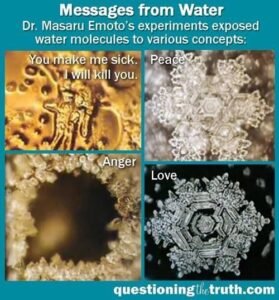The Fascinating and Controversial Research of Masaru Emoto on Water Crystallization

Masaru Emoto, a Japanese researcher and author, gained international attention for his unconventional studies on water crystallization. His work claimed that human thoughts, words, and emotions could influence the molecular structure of water, leading to a deeper exploration of the relationship between consciousness and the natural world. While his research sparked interest in alternative healing and spirituality, it has also faced significant criticism from the scientific community.
The Concept of Water and Consciousness
Emoto’s core idea revolved around the belief that water is a living entity capable of storing and responding to information. He posited that water could be influenced by human consciousness, asserting that our intentions and emotions could impact its molecular structure. This concept led to the hypothesis that positive thoughts and words would yield aesthetically pleasing ice crystals, while negative ones would produce distorted or unattractive forms.

The Experiments
Emoto’s most famous experiments involved exposing water samples to various stimuli before freezing them. The methodology generally included the following steps:

- Sample Preparation: Water samples were placed in containers labeled with different words or phrases, such as “love,” “thank you,” “hate,” or “you fool.”
- Exposure: The samples were subjected to various environmental conditions, including music and spoken words. For instance, classical music was said to produce beautiful crystals, while heavy metal music led to distorted shapes.
- Freezing and Observation: After a period of exposure, the water samples were frozen, and Emoto examined the resulting ice crystals under a microscope. He photographed the crystals, illustrating his findings.
- Analysis: Emoto claimed that crystals formed from water exposed to positive words were more symmetrical and aesthetically pleasing than those exposed to negative stimuli.
Visual Evidence
Emoto published numerous photographs showcasing the crystals formed under different conditions. These images visually supported his claims, with striking differences in the appearance of the crystals. The photos depicted beautiful, intricate patterns for samples exposed to positive messages and chaotic, malformed structures for those subjected to negative messages.

Criticism and Controversy
Despite the compelling visuals, Emoto’s work has faced substantial criticism from scientists and researchers. Key points of contention include:
- Lack of Scientific Rigor: Critics argue that Emoto’s experiments lacked control and reproducibility, essential components of the scientific method. Many of his studies were not conducted under rigorously controlled conditions, leading to questions about the validity of his results.
- Confirmation Bias: Some scientists suggested that Emoto may have exhibited confirmation bias, selectively focusing on the results that supported his hypothesis while disregarding those that did not.
- Absence of Peer Review: Much of Emoto’s work was not published in peer-reviewed journals, further undermining its credibility in the scientific community.
- Alternative Explanations: Critics also proposed that the observed differences in crystal formation could be attributed to environmental factors, such as temperature fluctuations or impurities in the water, rather than the influence of human thoughts and emotions. Cultural Impact
Despite the skepticism surrounding his work, Masaru Emoto’s ideas have resonated with many individuals interested in alternative healing, spirituality, and holistic approaches to health. His findings have inspired a range of practices, including meditation, positive affirmations, and intention-setting, as people seek to harness the purported power of consciousness to influence their surroundings.
Emoto authored several books, including The Hidden Messages in Water, where he discussed his experiments and their implications for understanding the relationship between humans and water. His work has sparked conversations about the interconnectedness of emotions, energy, and the natural world.
Masaru Emoto’s research on water crystallization presents a captivating intersection of science, spirituality, and human consciousness. While his claims have been met with skepticism and criticism from the scientific community, the impact of his work on popular culture and alternative healing practices cannot be understated. As our understanding of water, consciousness, and the environment continues to evolve, Emoto’s legacy remains a thought-provoking subject of discussion and exploration.

